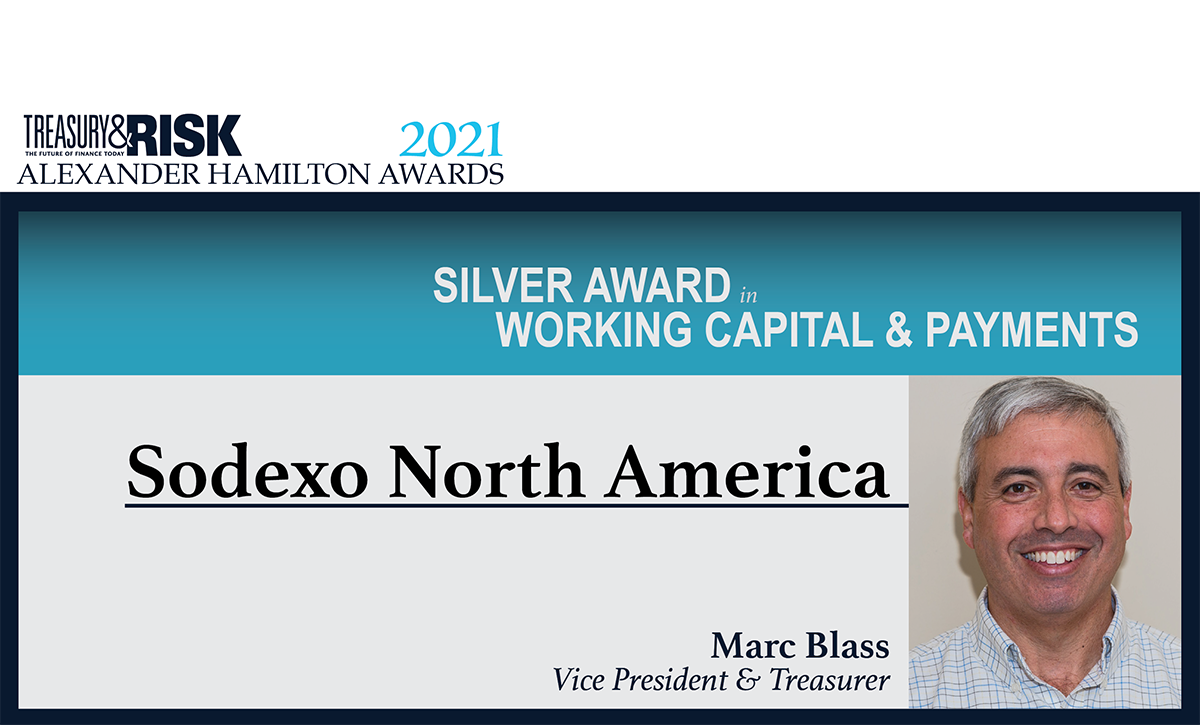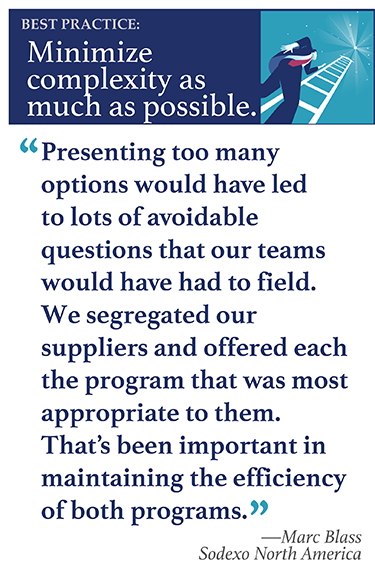
Sodexo is a global company that provides an assortment of services to other businesses, including catering, facilities maintenance and management, and employee benefits. Pre-Covid, the company’s North America region brought in more than $10 billion in annual revenue by enabling organizations in industries such as healthcare, education, oil and gas, and sports and leisure to focus on their core competency. Within a hospital, for example, Sodexo might provide cafeteria services, patient portering, and concierge services, as well as operating the gift shop.
The Covid-19 pandemic had a significant impact on some of the industry sectors Sodexo serves. The company’s North American treasury team and payment shared service center were already re-evaluating their payment processes. “Years ago, the industry norm was to grant clients 30-day payment terms, and we generally had slightly longer terms to pay our vendors,” says Marc Blass, vice president and treasurer of Sodexo North America. “As our business grew, the model generated working capital for us. That model started changing well before Covid—many of our larger global clients saw an opportunity to extend their terms as consolidation in our industry increased competition.”
But the pandemic didn’t help. “We continue to feel pressure,” Blass adds. “Some large, global clients are asking for extended terms, and carrying those receivables puts pressure on our working capital. … As the money coming in started to come more slowly, we needed to find ways to slow down the rate at which money was going out.”
Blass and his team did not want to just extend payments to their suppliers. He explains: “With many of our large vendors, we view our relationship as a partnership. A simple, across-the-board increase in payment terms would not fit with how we view our supply-chain partners.”
Two alternatives were more appealing, although neither would work well for every vendor. The first was payment cards. “When you pay your vendor with a card, you gain another 30 days to pay your bank. That essentially increases your payment terms,” Blass points out. This seemed a good solution for vendors that sold to Sodexo in small volumes. However, Blass says, “we spend more than $1 billion with our largest supply-chain partner.” At that volume, the card processors’ fees made payment cards unappealing. For the company’s largest contracted vendors, a different approach—supply-chain finance—offered an alternative way to extend the length of time Sodexo has to pay without making vendors wait for the cash flow.
“We felt supply-chain finance could create a true win-win situation for our large suppliers,” Blass says. “Not only could the vendors receive their funds faster, but they could leverage Sodexo’s creditworthiness in the discounting that occurs between them and the bank. A lot of our vendors were borrowing funds based on their own creditworthiness. Since Sodexo is a highly rated company, a product like supply-chain finance allows us to extend our creditworthiness to those vendors. Even when we increased our payment terms with them, their all-in cost of capital might actually come out lower.”
This approach didn’t make sense for smaller-volume vendors, though. “With supply-chain finance, there’s a lot of work involved in setting up new vendors, so it may not make sense for suppliers with which we have one-time payments or low dollar volumes,” Blass says. “If we can put a card in the hand of the purchasing manager, a lot of the reporting and administrative burden goes away.”
 Thus, the treasury team worked with Citi to develop two new payment programs. The Visa Payables virtual purchasing card program consolidates companywide payments to a given supplier and streamlines processing. Business units use the company’s standard process for invoice submission and approval, but rather than paying via check or ACH, the accounts payable (A/P) team issues a batch payment file to Citi.
Thus, the treasury team worked with Citi to develop two new payment programs. The Visa Payables virtual purchasing card program consolidates companywide payments to a given supplier and streamlines processing. Business units use the company’s standard process for invoice submission and approval, but rather than paying via check or ACH, the accounts payable (A/P) team issues a batch payment file to Citi.
“We could have 100 business units buying goods from a particular vendor,” says Mark Dobosz, senior director of finance and leader of purchase to pay for Sodexo North America. “Those businesses have no idea whether the vendor has been enrolled in the virtual card program. They submit their invoices, and we send a file to Citi authorizing payment. Then Citi generates a virtual card number and sends it to the vendor, which processes the card number using their existing credit card processing.”
Managers within the company’s field operating units also have the option of using plastic purchasing cards to make one-time or emergency payments, thereby eliminating the need to set up these vendors in the corporate A/P system and minimizing the need for idle petty cash at the business units. Whether the purchaser uses a virtual or physical card, Sodexo North America gains 30 additional days to pay.
Meanwhile, the treasury group developed a supply-chain finance program that gives large, strategic suppliers the option to receive funds more quickly, even as Sodexo extended payment terms by 30 days to most suppliers. Those that enroll in the program can sell their receivables to Citi in exchange for payment in 10 to 15 days from the date Sodexo approves the invoice for payment. This extends Sodexo’s credit strength with Citi to the suppliers, while also standardizing payment terms and improving working capital.
Both programs are large. The supply-chain finance program processed significantly more than $1 billion in spend during 2019. And the combined virtual purchasing card and physical purchasing card program, which encompasses processing more than 300,000 invoices annually and includes 4,500 physical cards, represented well over $100 million in annualized volume in 2019. Streamlining accounting and reconciliations was crucial in development of both payment methods.
To that end, the Sodexo North America payments shared service center created a liability account in the company’s SAP enterprise resource planning (ERP) system for each program. When the company sends a batch file to Citi, it deems each payment as having been made and moves it into the SAP liability account. But the payment isn’t actually funded until it’s contractually due—when Citibank debits Sodexo’s account, in the case of supply-chain finance, or when Sodexo pays its monthly purchasing card statement on its due date. Reconciliation is crucial in ensuring that the payments deemed paid have actually been funded.
“For the purchasing cards, we worked with the team that developed our expense report tool to determine how we could build a report identifying transactions that have already been posted within our billing cycle but have not been released,” explains Lorene Mietz, manager, vendors, in the payments shared service center. “We generate reports out of Citi Manager for the plastic cards, and from Visa for the virtual cards. These reports clarify which transactions have already been included in a payment that went out, and which are still waiting to be processed. I use that to reconcile the card payments within SAP.”
Reconciliation follows a similar path for the supply-chain finance program. “We create a separate liability, which we move to the liability account to reflect that we made the payment via supplier finance,” explains Stephen Dabrowski, senior accounting manager and invoice processing lead. “A system called Frontier automates reconciliation for the supply-chain finance transactions. It pulls in data from Citibank and from SAP, and auto-matches all those transactions to confirm that what we’ve approved is what we’re funding.”
One key concern in the development of this approach was that it might create confusion among suppliers. The treasury team worked with the company’s supply management team to educate vendors. “Presenting too many options would have led to lots of avoidable questions that our supply management or A/P teams would have had to field,” Blass says. “So we segregated our suppliers by annual spend and other factors, and offered each supplier the program that was most appropriate to our relationship with them. That’s been important in maintaining the efficiency of both programs.”
He estimates that, as a result of this payments transformation, Sodexo North America has reduced the number of check and ACH payments processed annually by more than 300,000. It has generated a cash flow benefit in excess of $100 million annually through the effective extension in terms on a significant portion of the company’s purchase volume.
The keys to the program’s success, according to the team, were stakeholders’ flexibility while they explored the options, and “testing, testing, testing,” Blass says. “When you go into a new program like this, make sure the files are getting sent and then coming back like they’re supposed to.
“For years and years and years, we had been doing only ACHs and checks,” Blass concludes. “Then we introduced a new way to pay, by sending a file to our bank. We learned a lot from that process, and at this point everybody on our team has become an expert on how to create these types of programs. Now we’re building on those learnings to add more batch payment files under different programs. We’re leveraging our successes with this program to continue to improve efficiency throughout the Sodexo North America treasury and payments groups.”

"payment" - Google News
October 22, 2021 at 01:54AM
https://ift.tt/3jppG8C
Multipronged Payment Strategy Boosts A/P Efficiency Across Diverse Supplier Base - Treasury and Risk
"payment" - Google News
https://ift.tt/3bV4HFe
https://ift.tt/2VYfp89
Bagikan Berita Ini














0 Response to "Multipronged Payment Strategy Boosts A/P Efficiency Across Diverse Supplier Base - Treasury and Risk"
Post a Comment